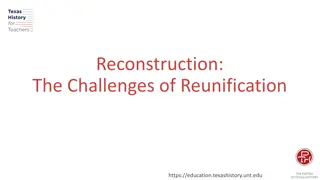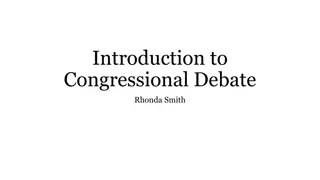
Reconstruction Plans and Key Questions: Lincoln's, Johnson's, and Congressional Perspectives
Delve into the Reconstruction era following the Civil War, exploring the contrasting approaches of President Lincoln, President Johnson, and Congress. Key questions on governance, reintegration, rebuilding, and emancipation arise, shaping the turbulent post-war landscape.
Download Presentation

Please find below an Image/Link to download the presentation.
The content on the website is provided AS IS for your information and personal use only. It may not be sold, licensed, or shared on other websites without obtaining consent from the author. If you encounter any issues during the download, it is possible that the publisher has removed the file from their server.
You are allowed to download the files provided on this website for personal or commercial use, subject to the condition that they are used lawfully. All files are the property of their respective owners.
The content on the website is provided AS IS for your information and personal use only. It may not be sold, licensed, or shared on other websites without obtaining consent from the author.
E N D
Presentation Transcript
Page 34 Reconstruction
Key Questions What branch of government should control the process of Reconstruction? How do we bring the South back into the Union? How do we rebuild the South after its destruction during the war? How do we integrate and protect newly- emancipated black freedmen?
RECONSTRUCTION PLANS Lincoln s Plan Johnson s Plan Congressional Plan
President Lincolns Plan President Lincoln s Plan The 10% Plan BACKGROUND: Proclamation of Amnesty and Reconstruction * Replace majority rule with loyal rule in the South. * He didn t consult Congress regarding Reconstruction. * HOW: When 10% of a state s voting population in the 1860 election had taken an oath of loyalty and established a government, that state re-admitted. * CONSEQUENCES: Wanted to make the South s transition as easy as possible. Wanted to minimize bitterness and anger so country could move forward so few consequences for fighting the Civil War *
President Lincolns Plan President Lincoln s Plan The 10% Plan Pardon to all but the highest ranking military and civilian Confederate officers. * PLAN for FREEDMEN: States had to allow slaves to remain free *
President Andrew Johnson President Andrew Johnson Abraham Lincoln assassinated by Confederate sympathizer John Wilkes Booth on April 15, 1865 Vice President Andrew Johnson inherits the Presidency and the issue of Reconstruction after Lincoln s death Agreed with Lincoln that states had never legally left the Union. Felt that the wealthy southerners were the ones responsible for secession, so they should face the consequences Wanted to spare poor southerners too many penalties
PRESIDENT JOHNSONS PLAN Johnson thinks Lincoln s plan a bit too lenient Comes up with a similar plan that is slightly tougher 10% of voters have to take loyalty pledge (like Lincoln s plan) Adds the requirement of a presidential pardon for former Confederate government and military officers and southerners owning property over $20,000 States had to abolish slavery and ratify the 13th amendment
THE CONGRESSIONAL PLAN THE CONGRESSIONAL PLAN Known as the Wade-Davis bill, after its sponsors Congress felt the south should face harsh punishment for its actions Required 50% of the number of 1860 voters in a state to take an oath of allegiance (swearing they had never voluntarily aided the rebellion ). Senator Benjamin Wade (R-OH) Congressman Henry W. Davis (R-MD) Required a state constitutional convention before the election of state officials. Enacted specific rights to protect freedmen s liberties. States had to ban slavery Only after all these criteria were met would states be readmitted to the Union
13 13th th Amendment Amendment Passed to ensure the permanent removal of slavery since Emancipation Proclamation only addressed the Confederate states Ratified in December, 1865. Made slavery illegal throughout the United States Former slaves now free to marry legally and to travel without documentation Many demanded the same economic and political rights as whites, though they were unprepared for what to do with those rights
Freedmens Bureau (1865) Freedmen s Bureau (1865) Established to provide relief for poor southerners white and black. Distributed food to the poor, helped to find housing and employment Many former northern abolitionists came south to help southern freedmen. These people often called carpetbaggers by white southern Democrats. Often faced with risky situations due to anti-northern sentiments Freedmen s Bureau also helped to promote education in the south Began to open schools for blacks Eventually opened more than 3,000 schools, and went on to establish several colleges including Fisk University in Nashville, TN and Howard University in Washington, DC
Freedmens Bureau School Freedmen s Bureau School
Growing Northern Alarm Growing Northern Alarm Many Southern state constitutions fell short of minimum requirements. Johnson granted 13,500 special pardons. In the first two years of Reconstruction, just one state was readmitted to the Union (TN in 1866) Revival of southern defiance BLACK CODES
Black Codes Black Codes An improvement over slavery, but blacks still had restrictions that whites did not endure Blacks could own certain types of property, could testify in cases involving other blacks, and existing marriages proclaimed legal Blacks could still not allowed to vote or serve on a jury, prevented from renting or leasing land, and forced into strict labor contracts *labor contracts could come with high fines and forced unpaid labor if contracts broken Restored pre-war system of race relations. (Whites with power, blacks with little/no power)






















